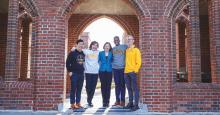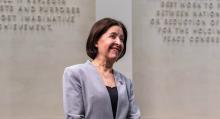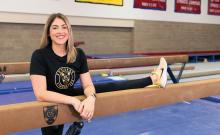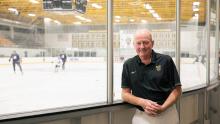Kauss and Sviggum see a common sensibility between their employer and their alma mater. It starts with Mayo’s three-shield approach to medicine that encompasses clinical care, research, and education. The concept emphasizes patient-centered medicine that inspires inquiry and teaching the next generation. Similarly, Gustavus is known for its whole-person, liberal arts education that allows students to explore all of their interests and discover new ones.
That was the case for Sviggum, who played on the Gustavus basketball team. A biology and biochemistry major, Sviggum especially enjoyed his non-science classes in Bible and art appreciation. Kauss, a biology major with a minor in music, adored playing French horn in the band and symphony and living in the International Center, where she delved into learning about other cultures and religions.
“All of these things made me so well rounded,” says Kauss, who came to Gustavus from Scranton, North Dakota, a town of about 250 people. “I love where I grew up. But Gustavus showed me that the world is a big place filled with so many different people and cultures, and that they all intertwine. It’s important at Mayo because we are exposed to people coming here from around the world for care. It helps me understand patients’ needs and cultures that might be different from my own and makes me a better physician.”
Gustavus imprinted Sviggum with a style of learning that still endures. “The education I received at Gustavus taught me how to think critically about problems rather than just regurgitating facts,” he says. As a physician, “there are a number of situations where just knowing the facts won’t allow you to take the best care of your patients. You need to analyze situations and apply critical thinking.”
Kauss and Sviggum practice in different areas of anesthesiology and perioperative medicine but often overlap when it comes to providing obstetrical anesthesia. Sviggum, head of Mayo’s obstetric anesthesiology practice, regularly helps women in labor, during cesarean deliveries, or after a birth. Kauss specializes in cardiothoracic anesthesia and spends the bulk of her clinical time with people having open heart surgery, vascular surgery, or other procedures. She also has an interest in cardiac obstetrics. Kauss treats pregnant or laboring patients who are high risk for cardiovascular complications, whether from high blood pressure or a previous heart surgery, or whose babies have known congenital heart diseases. And the two belong to a Gustie contingent of Mayo anesthesiologists that includes Nicole Beatty ’00, Rochelle Molitor Pompeian ’10 and Tasha Pike Welch ’05.
What I try to teach comes from my time at Gustavus and the values that I learned—that everyone matters, and every person is unique."
-Marissa Brown Kauss '09
Lately Kauss and Sviggum’s work has expanded to include more perioperative medicine—that is, anesthesiology that happens before, during, or after surgery. Through this focus, they ease chronic pain, counsel patients on optimizing their health before surgery, and help with pain management during procedures such as colonoscopies and bone marrow biopsies. They also are forging new ground with techniques that help patients recover faster from surgery. “Enhanced recovery is a growing area of anesthesiology,” Kauss says. “What can we do as providers to keep your pain controlled but get you up and moving and recovering faster after surgery? What we do can have a significant impact on how hospital stays are going and whether we can shorten patients’ length of stay.”
As well-rounded Mayo physicians, Sviggum and Kauss engage in research and education, too. Kauss does research in physiology, while Sviggum focuses on exploring obstetric anesthesiology. They also spend significant time teaching Mayo residents—a highlight for both. Sviggum models his teaching style on the warm, nurturing relationships he had with many Gustie faculty. “I strive to be open, engaging, and really meet our residents on a personal level because that’s the kind of treatment I got from my professors at Gustavus,” he says. He also aims to teach residents the art of medicine on top of the important technical and scientific aspects of anesthesiology. “We teach them how a medication acts on an alpha receptor or how to place an epidural,” Sviggum adds. “We also teach them how to take that knowledge and apply it with a patient who is scared or nervous, in a humble way and with an attitude that gains their trust.”
Kauss, who serves as associate director of the cardiothoracic anesthesia fellowship, encourages residents and fellows to build bonds with patients that deepen trust. It’s especially important when someone is heading into a vulnerable situation like going under during surgery. “What I try to teach comes from my time at Gustavus and the values that I learned— that everyone matters, and every person is unique,” Kauss says. “Sometimes taking the time to find each person’s unique thing not only makes us better at applying the science we know, it makes patient outcomes, and how they perceive those outcomes, better.”
The physicians are proud to be Gustavus alums who work at Mayo, finding links between the two institutions’ bedrock beliefs that shaped them into the people and doctors they are today. Kauss thinks about the faculty, who truly know their students, show they care about them, and push them to be better. Sviggum sees it in Mayo’s and Gustavus’ shared love and commitment to excellence. Whether it is athletics, music, theater, or academics, Gusties strive to be exemplary, and so do Mayo physicians.
“We’re always wanting to be better than we were yesterday,” Sviggum says of his team’s drive toward excellence. “Another big similarity is how we treat other people. The adage at Mayo is that the needs of the patient come first. As doctors, we’re here to take care of the patient. And you see a similar mantra at Gustavus—that people look out for each other and try to do their best for the people who surround them.”







